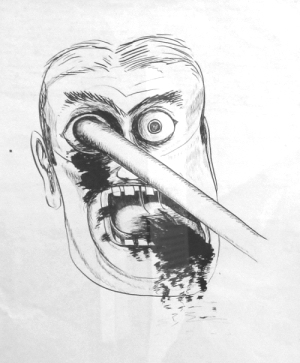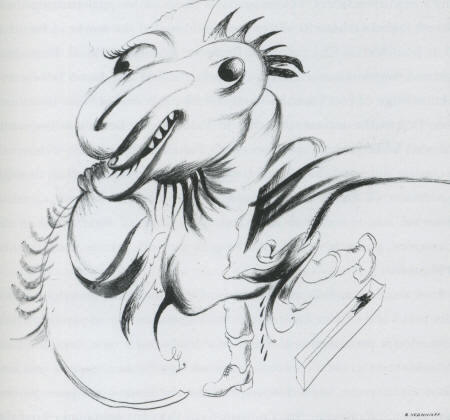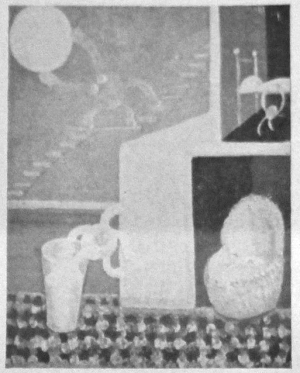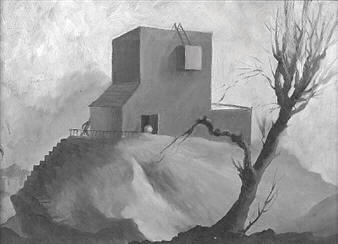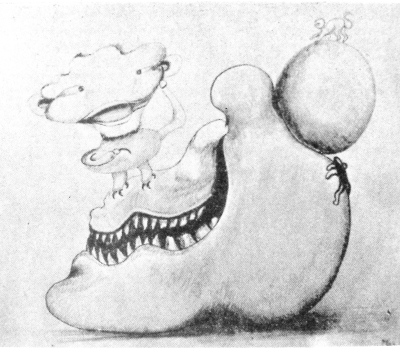|
|
| home | exhibitions | interviews | features | profiles | webprojects | archive |
|
The Scientific Aspect of Surrealism G W Pailthorpe Published originally in the London Bulletin, No 7, December 1938-January 1939
In 1934 André Breton, one of the founders
of Surrealism and its present leader, defined Surrealism as: - Psycho-analysis, although originally the outcome of a different aim, also strives to free the psychology of the individual from internal conflict so that she or he may function freely. Thus it can be assumed that the final goal of Surrealism and Psycho-analysis is the same-- the liberation of man-but that the approach to this end is by different paths. During the process of a research, undertaken from the psycho-analytic point of view (by my colleague and myself), the results of certain experiments in painting and drawing led to Surrealism. A considerable amount of interesting material was collected and in it some of the real values of Surrealism became manifest. As a detailed description of the progress of this research is impossible in the limited space of this journal only a brief idea of some of the results, and the light these throw on the whole subject of art, will be practicable. It is well-known that unconscious fantasy is at work in all Surrealist creations; but that the fantasy-story the unconscious is unfolding is intelligible is not such common knowledge. The telling of some of those stories is one of the purposes of this article. Although the method by which the interpretations of drawings and paintings were obtained is complicated, the results are crystal-clear. For instance it can be clearly demonstrated that one unconscious meaning of traditional art (art that has become established and accepted) is painting according to parental wishes, or to please the parent. Such creations may display excellent craftsmanship but very little, if any, of the creator's basic personality, and vitality is restricted. Further, it is possible to show that
painting freely, that is Surrealistically, may, in the unconscious mean
either the making of a mess, a diarrhoea or a preference for making
stools all over the place instead of into the chamber. On the other hand
it may have quite opposite meanings as for example, the making of a
child, or the search for something of interest in the stools. But
whatever the act of painting may symbolise there is always an underlying
reason for it. A fantasy is in progress and a story is being told, as
the following example and interpretation illustrate.
G W Pailthorpe Pen drawing
In this research material there is evidence of the fact that early enforced restrictions on the infant's excretory functions inhibits fantasy life and, therefore, its imagination. A healthy or balanced imagination is of vital importance. The repression of this faculty, which lack of understanding has made widespread, leads to a condition which the New Testament describes as, 'a house divided against itself which cannot stand'. Thus today there is the slow disintegration of all civilizations because the units that constitute society are not psychologically (and, therefore, not biologically) integrated. Art within the confines of any tradition is
like an animal in a cage. An imprisoned creature will lose much of its
inherent grandeur and vitality. A cramped freedom can only permit a
mockery of life. There is little scope for fantasy within the cage of
tradition-bound art. Art that is free from restriction becomes alive,
colourful and vital. With these preliminary remarks in mind we can now turn to the consideration of some selected paintings and drawings. 'Free translations' from the works of some of our prominent Surrealist painters, such as Dali, Miro or Tanguy, may be interesting but they would be unreliable. They would be entertaining but they would not fit into the purpose of this article. Concrete facts are more convincing and, for this reason, the examples given are taken from the research since, in this case, one can answer for the accuracy of the interpretations. Before giving the interpretations of the following illustrations it is necessary to impress upon the mind that the infantile fantasies underlying the pictures are not in consciousness at the time of painting or drawing. The unconscious story is brought into consciousness by a special technique. Thus a hill or a house mean exactly what they are to the artist while working. All that is known at the time is that a house is appearing, a hill is appearing, and so on. To the degree that one is able to give oneself entirely up to the dictates of the unconscious, to that degree the perfect story will be told. Conscious interference in the painting can always be detected, since it invariably distorts the story in the fantasy-creation.
R Mednikoff Come back soon
The underlying unconscious fantasy is that the artist has killed his mother and is now enjoying himself with playing with the mess the kill has provided for him. To do this he has first to decorate himself with a cock's-comb and the beard. By doing this he is putting himself into the position of those who are permitted to kill. In his childhood he has witnessed 'kosher-killing of poultry. Priests with beards become to his child-mind the people who may kill; therefore, in his fantasy, he first makes himself into a priest with a beard. To make doubly sure he is this kind of a priest and none other he puts the cock’s-comb on his head. Thus he is saying, 'I am a priest who kills chicken'. It may not be generally known that this form of killing birds and animals for the table is a religious rite and is only performed by those set aside for this purpose. The dead bird represents the mother. The title which the artist gave to this drawing was 'Come back soon'. Death as an extinction of life does not exist in the realm of the unconscious. So although the play of the moment demands the death of the mother in order to play with the mess, he makes sure of its impermanence by his title. The inverted flower represents the fowls he had seen hung up upside-down from which blood dripped. It is not necessary to go into further details as to the fuller meaning of the picture. It suffices to demonstrate the importance of every detail of the picture. It will be noted that even the character of the lines is of importance. The smudgy quality of those lines symbolise the nature of his play while the drop-like character of that which in the flower are the stamens, are a further example of it.
G W Pailthorpe Oil, April 1st 1938
R. Mednikoff Oil, September 19 (1935)
G W Pailthorpe Pencil Drawing (1938)
All these pictures came into being as a result of the experimental work of the research. The details and interpretations of these pictures have necessarily been curtailed; but they serve to show the quantity of interest held within the bounds of each. Not a line or detail is out of place and everything has its symbolic meaning. This also applies to colour. Every mark, shape and colour is intended by the unconscious and has its meaning. The unconscious is a master in its own form
of art and its creations have qualities similar to those demanded of any
form of art, whatever the media. It tells its story perfectly; with
economy of language and with associations that convey the maximum
effect. It gives only those details necessary for the complete
understanding of its moods. It tells a perfect short story. Simplicity,
directness and lucidity are its aims. It conforms to all that has
vitality, perfection of rhythm and composition and it cannot be ignored
because it is truth expressed with vitality. Every unconscious creation is not a work of art but where complete freedom has been possible the results are perfect in balance, design, colour, rhythm and possess a vitality that is not to be found anywhere else than in Surrealism. Because it is free from the limitations of traditionalism its movements have greater variation and infinitely greater daring. Unfortunately such paintings and drawings create a feeling of fear or distaste on the part of the public; but if they can bring themselves to look again and again they begin to feel an inexplicable attraction towards these pictures. They are being drawn towards a freedom which they, too, would like to experience. Eventually they admit that, although they do not understand Surrealism, there is an indefinable attraction which excites them. And many artists, who still conform to the dictates of traditionalism, have admitted to being profoundly affected by the vitality of the colour, movement and design of Surrealist creations. At present we are in the early stages of this form of art. The infantile unconscious can only become free gradually. Its stiffened limbs have to overcome the effects of previous binding. It has to overcome the fear of abandoning its cage, which is in large part of its own making in protection of itself from attacks from the external world. Until these bonds are broken and 'limbs' are fully stretched it will be impossible to get that perfection which is called 'creation'-the conglomeration of qualities that make a thing 'live', and by which it stands the test of time. We are witnesses of the birth of a new form of art, of the transitional period during its progress from within to without. Surrealism is ushering into the world an art greater than has hitherto been known, for its potentialities are limitless. And this art of the future will arrive when completely freed fantasy evolves from uninhibited minds. It will be the dawn of a new art epoch. As long as fantasy-life, or the imaginative life, is free it learns by experience. The fantasies produced are richer in quality and content as a result of experience. But fantasy or imagination bound by early infantile inhibitions and fears remains infantile in what it creates. In the process of becoming free Surrealist paintings, drawings and sculpture will necessarily be infantile in content. This does not preclude its right to be called art. The infantile fantasy, as it becomes freer and experiences more as a result of that freedom, will grow increasingly more adult in character and its creations will show it. Imagination travels well in harness with reason. The infant human comes into the world with a remarkable power to reason. It reasons through its senses. Its mistakes are not through lack of power to reason but through lack of experience. Hitherto humanity has stressed the value of reason and has restricted imagination. Imagination and reason are biological twins. They must grow up together. What affects the one will affect the other. If their development is such that one grows apace and the other remains stunted the results are disastrous. The growth of our imagination and reason must, like our mental and physical development, be balanced. They are interdependent. The crippling of one or other has its immediate effect on the living organism. The inhibition of fantasy-life, from whatever cause (internal or external), must result in a crippled creation. Equally, any loss of freedom in the use of one's reason results in a similar distortion. According to the degree we suffer from such mishandling, to that degree we are narrow, hidebound, mentally unhappy and limited individuals and, at worst, are among the many unfortunates who end their days in asylums, workhouses or prisons. Surrealism is a serious project. If followed wholeheartedly to its final goal it has the power to bring happiness to all humanity. But it is a discipline, and one that must be persistently pursued if anything of value is to be the outcome and if disaster is to be avoided. There are no half-way houses. There are many dangers in the achievement of this aim but these can be circumnavigated. The object of Surrealism is to know the self. All the sages of the past have advocated self-knowledge but they have not shown us how to reach that ideal. Here is the opportunity.
*'What is Surrealism?' by Andre Breton p.59 (Faber and Faber)
|
|
|

